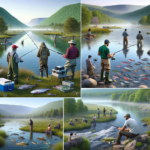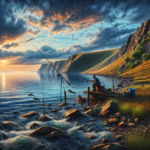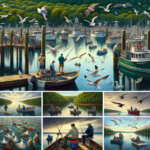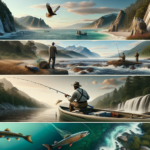Fishing in Pennsylvania: Rivers, Lakes, and Reservoirs

Introduction
Did you know that Pennsylvania boasts over 85,000 miles of rivers and streams, along with 4,000 lakes and reservoirs? This makes it a paradise for anglers of all skill levels. Whether you’re a seasoned pro or a weekend warrior, Pennsylvania offers a diverse range of fishing opportunities that cater to every preference.
In this article, we will explore the rich fishing landscape of Pennsylvania, covering its rivers, lakes, and reservoirs. We will delve into the best fishing techniques, the species you can expect to catch, top fishing spots, and essential gear. Additionally, we will discuss seasonal considerations, local events, and tournaments, as well as provide tips and best practices to enhance your fishing experience.
Understanding the fishing opportunities in Pennsylvania is crucial for anyone looking to make the most of their angling adventures. Whether you’re aiming to find the best fishing spots, master a new technique, or prepare for an upcoming event, this comprehensive guide has you covered.
Background/Context
Historical or Cultural Significance
Fishing has been an integral part of Pennsylvania’s history and culture for centuries. Native American tribes, such as the Lenape and Susquehannock, relied on the state’s abundant waterways for sustenance. European settlers continued this tradition, and fishing became a popular recreational activity in the 19th and 20th centuries. Today, fishing remains a beloved pastime, contributing to the state’s tourism and local economies.
Geographical Overview
Pennsylvania’s diverse geography includes the Appalachian Mountains, rolling hills, and fertile valleys, all of which contribute to its rich aquatic ecosystems. The state experiences four distinct seasons, with cold winters and warm summers, making it an ideal location for various fishing activities year-round. Key water bodies include the Susquehanna River, Delaware River, Lake Erie, and Raystown Lake, each offering unique fishing experiences.
Key Points/Details
Fishing Techniques
Technique Overview
Pennsylvania’s diverse waterways allow for a variety of fishing techniques, including fly fishing, spin fishing, and ice fishing. Fly fishing is particularly popular in the state’s numerous trout streams, while spin fishing is commonly used in lakes and reservoirs. Ice fishing is a favorite winter activity on frozen lakes.
When and Where to Use
Fly fishing is best suited for the spring and fall seasons when trout are most active. Popular fly fishing spots include Penns Creek and the Little Juniata River. Spin fishing can be enjoyed year-round in lakes such as Lake Wallenpaupack and Pymatuning Reservoir. Ice fishing is typically done in January and February on lakes like Presque Isle Bay and Lake Arthur.
Recommended Gear
- Fly Fishing: 9-foot, 5-weight fly rod, floating fly line, and a variety of dry flies, nymphs, and streamers.
- Spin Fishing: Medium-action spinning rod, 6-10 lb test line, and a selection of lures such as spinners, crankbaits, and soft plastics.
- Ice Fishing: Ice auger, short ice fishing rod, tip-ups, and live bait such as minnows or wax worms.
Species Information
Species Overview
Pennsylvania’s waters are home to a wide range of fish species, including trout, bass, walleye, catfish, and panfish. Trout species include brook, brown, and rainbow trout, which thrive in the state’s cold-water streams. Largemouth and smallmouth bass are abundant in lakes and rivers, while walleye and catfish are commonly found in larger reservoirs.
Best Practices
To successfully catch trout, use light tackle and natural baits such as worms or artificial flies. For bass, focus on structure such as submerged logs or weed beds and use lures that mimic their natural prey. Walleye are best targeted during low-light conditions using jigs or live bait. Catfish can be caught using stink baits or cut bait near the bottom of deep pools.
Location Information
Top Fishing Spots
- Susquehanna River: Known for its excellent smallmouth bass fishing, with numerous access points and boat ramps.
- Lake Erie: Offers world-class walleye and steelhead fishing, with charter services available for guided trips.
- Raystown Lake: A popular destination for striped bass and lake trout, with ample camping and lodging options.
- Pine Creek: Renowned for its fly fishing opportunities, particularly for wild brown trout.
Regulations and Licenses
Anglers in Pennsylvania must obtain a valid fishing license, which can be purchased online or at authorized retailers. Special permits are required for trout and salmon fishing. It’s essential to familiarize yourself with local regulations, including size and creel limits, as well as seasonal restrictions to ensure compliance and conservation.
Seasonal Considerations
Seasonal Variations
Fishing conditions in Pennsylvania vary significantly throughout the year. Spring and fall are prime seasons for trout fishing, while summer is ideal for bass and panfish. Winter offers unique opportunities for ice fishing on frozen lakes. Water levels, temperature, and fish behavior change with the seasons, requiring anglers to adapt their techniques accordingly.
Best Times to Fish
The best times to fish in Pennsylvania are early morning and late evening when fish are most active. Spring and fall are optimal for trout fishing, while summer is best for bass and panfish. Ice fishing is most productive during the coldest months of January and February.
Events and Tournaments
Event Overview
Pennsylvania hosts numerous fishing events and tournaments throughout the year, catering to anglers of all skill levels. Notable events include the Pennsylvania Bass Federation tournaments, the Lake Erie Walleye Trail, and the annual Trout Derby in Pine Creek.
Preparation Tips
To prepare for a fishing event or tournament, ensure your gear is in top condition and familiarize yourself with the event rules and regulations. Practice your techniques in advance and scout the fishing location if possible. Bring essential supplies such as food, water, and weather-appropriate clothing.
Tips and Best Practices
General Tips
- Always check local fishing reports for current conditions and fish activity.
- Use natural baits and lures that mimic the local forage.
- Practice catch and release to help sustain fish populations.
Avoid Common Mistakes
- Not checking local regulations: Always ensure you are aware of size and creel limits, as well as seasonal restrictions.
- Using the wrong gear: Match your tackle to the species you are targeting to increase your chances of success.
- Ignoring weather conditions: Pay attention to weather forecasts and adjust your plans accordingly to stay safe and increase your chances of a successful outing.
Advanced Techniques
- Mastering the art of fly casting can significantly improve your success rate in trout streams.
- Using electronics such as fish finders can help locate fish in larger lakes and reservoirs.
- Experimenting with different retrieval speeds and patterns can trigger more strikes from predatory fish.
Gear and Equipment Recommendations
Essential Gear
- Fishing rod and reel appropriate for your target species.
- Fishing line, hooks, and a variety of lures or baits.
- Tackle box with essential tools such as pliers, line cutters, and a hook remover.
- Fishing license and any required permits.
Optional Gear/Upgrades
- Polarized sunglasses to reduce glare and see fish more clearly.
- Waders for fishing in streams and rivers.
- Fish finder or depth sounder for locating fish in larger bodies of water.
Where to Buy or Rent
Fishing gear can be purchased at local sporting goods stores, such as Cabela’s and Bass Pro Shops, or online retailers like Amazon and Tackle Warehouse. Some locations also offer gear rental services, particularly near popular fishing destinations.
Safety and Conservation
Safety Tips
- Always wear a life jacket when fishing from a boat or near deep water.
- Be aware of weather conditions and seek shelter during storms.
- Carry a first aid kit and know basic first aid procedures.
Conservation Practices
- Practice catch and release to help maintain healthy fish populations.
- Respect local wildlife and avoid disturbing their habitats.
- Follow all fishing regulations and report any violations to authorities.
Planning Your Trip
Accommodations
There are numerous lodging options near Pennsylvania’s top fishing spots, ranging from campgrounds and cabins to hotels and resorts. Popular choices include the Raystown Lake Resort, Pine Creek Valley Lodge, and various campgrounds around Lake Erie.
Travel Tips
When planning your trip, consider the best routes to your fishing destination and any transportation needs. Many fishing spots are accessible by car, but some remote areas may require hiking or boating. Check local maps and GPS for accurate directions.
Additional Activities
Pennsylvania offers a variety of activities for non-fishing time, including hiking, bird watching, and visiting historical sites. Popular attractions include the Gettysburg National Military Park, the Pennsylvania Grand Canyon, and the numerous state parks and forests.
Frequently Asked Questions (FAQs)
Do I need a fishing license in Pennsylvania?
Yes, a valid fishing license is required for anyone aged 16 and older. Licenses can be purchased online or at authorized retailers.
What are the best times of year to fish in Pennsylvania?
Spring and fall are ideal for trout fishing, while summer is best for bass and panfish. Ice fishing is most productive during January and February.
What are some popular fishing spots in Pennsylvania?
Top fishing spots include the Susquehanna River, Lake Erie, Raystown Lake, and Pine Creek.
What gear do I need for fly fishing in Pennsylvania?
A 9-foot, 5-weight fly rod, floating fly line, and a variety of dry flies, nymphs, and streamers are recommended for fly fishing in Pennsylvania’s trout streams.
Conclusion
Pennsylvania offers a wealth of fishing opportunities across its rivers, lakes, and reservoirs. By understanding the best techniques, species, and locations, anglers can maximize their success and enjoyment. Whether you’re a seasoned angler or a beginner, this guide provides the essential information needed to make the most of your fishing adventures in Pennsylvania. So grab your gear, head to the water, and experience the thrill of fishing in the Keystone State.




